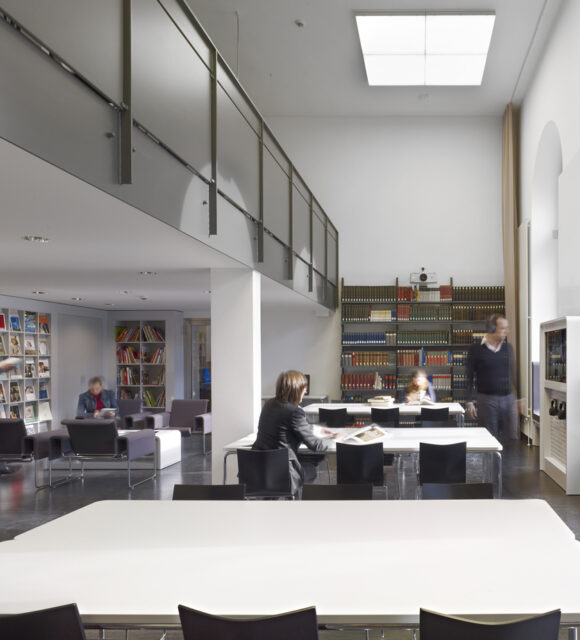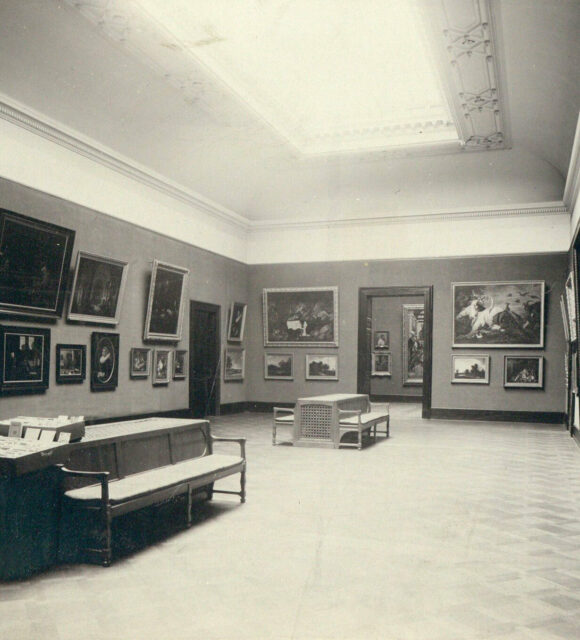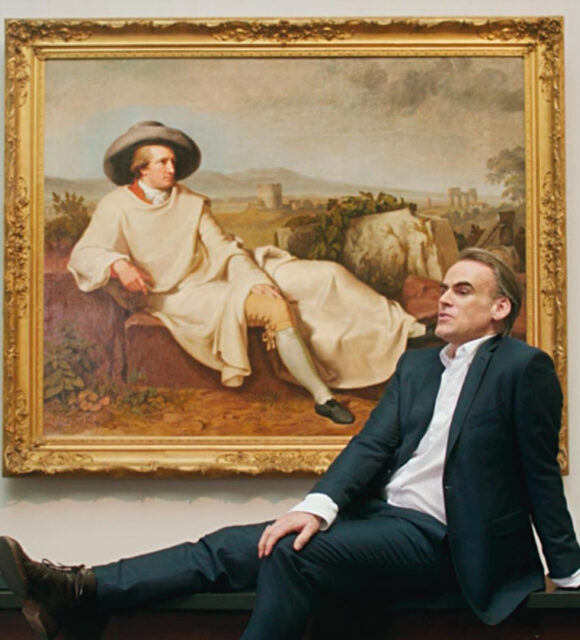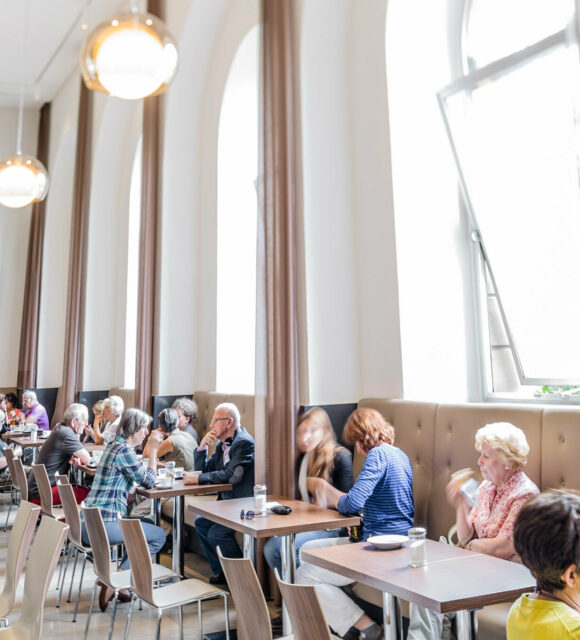Research & Conservation
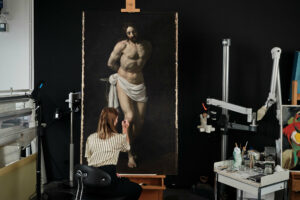
The research and preservation of art is a fundamental part of the museum’s work. Learn more about current research and conservation projects and have a look behind the scenes of our research departments. We offer scholars and visitors various means of carrying out their own studies—on site and online.
Your Research
at the Städel Museum
The Städel Museum’s Department of Prints and Drawings oversees a collection of some 100,000 drawings and prints dating from the Late Middle Ages to the present. Owing to its high quality, it is one of the most distinguished collections of its kind in Germany. View the sensitive holdings close up in the Study Room.
The Städel Museum’s library and mediatheque provide the means of delving deeper into the world of art. The reference library offers audiovisual media, images and extensive literature to all interested visitors.
The historical archive of the Städel Museum brings together more than 150 years of museum and collection history.
Learn more and find out about registration and opening hours. We look forward to your visit.
Digital Collection
Stroll digitally through 700 years of art or search specifically for your favourite work of art.
Current
Research Projects

Museological research preserves and broadens knowledge of the cultural legacy that is preserved by museums and forms the scholarly basis for collections and exhibitions.
Provenance research and historical archive
The focus of the Städel’s provenance research activities in 2023 were four works which provenly changed hands in connection with persecution during the Nazi period: the “Portrait of Prof Karl Herxheimer” (1911) by Ottilie W. Roederstein, whose history has been the subject of comprehensive study, and three objects which were returned to the heirs of the former owners. Apart from Fritz von Uhde’s “Portrait of a Lady” (1890), sold to the City of Frankfurt in 1937 by the businessman Gustav Rüdenberg (1868–1941) of Hanover, these works comprise two Baroque angels from the workshop of Meinrad Guggenbichler, originally elements of an altarpiece of around 1704. In the Liebieghaus holdings since 1938, the angel figures once belonged to the physician David Rothschild (1875–1936) of Frankfurt.
In collaboration with the museum education department, a concept for a digital archive was developed for the Städel’s historical archive. In the future, the digital archive will make thematically selected holdings acquired over the course of the museum’s 200+-year history accessible online. The pilot project is the Ottilie W. Roederstein estate in the Roederstein-Jughenn Archive (see digital projects). Selected holdings from this collection are expected to be available digitally from autumn 2024.
Project lead
Iris Schmeisser
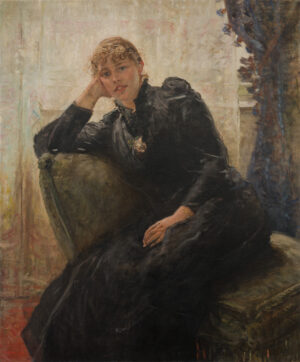
Fritz von Uhde
Portrait of a Lady (Portrait of Therese Karl), 1890
Collection Catalogue of German Paintings in the Städel Museum, 1725-1800
Funded by the Deutsche Forschungsgemeinschaft (DFG; German Research Foundation) from 2023 onwards, this project is devoted to an area of the Städel Museum collection that has yet to undergo thorough examination. Continuing the thread of the predecessor project, it is focussing on paintings carried out in eighteenth-century Germany.
The 137 works that make up these holdings are distinguished by the heterogeneity and strong regional influence typical of eighteenth-century German painting. The highlights include pieces by Angelica Kauffmann, Jakob Philipp Hackert and the world-famous “Goethe in the Roman Campagna” by Johann Heinrich Wilhelm Tischbein. Small-scale cabinet paintings by the so-called Goethe Painters of Frankfurt, among them examples by Christian Georg Schütz the Elder, Justus Juncker, Johann Georg Trautmann and Johann Conrad Seekatz, account for a large proportion of the collection. Portraits of the von Holzhausens, a patrician family of Frankfurt, and works of the Southern German Rococo make up further substantial sub-sections.
As has been the case with the preparations for the Städel’s other Old Masters scholarly catalogues, the investigation of these paintings closely intertwines the art-historical and technical-scientific perspectives. Methods such as microscopy, infrared reflectography and micro-X-ray fluorescence analysis are being employed to gain insights into the processes by which the works were made. The project will document the history of every painting and discuss it against the background of art- and cultural-historical research questions. Discourses on such matters as the social history of artists, the reception of Dutch art and art market research are particularly relevant in this context. The results will be published in a scholarly collection catalogue.
The project is being carried out under the supervision of Dr Friederike Schütt; the responsibility for the technological examinations of the paintings resides with the certified conservator Lilly Becker.
Project lead
Dr. Friederike Schütt
Art technological research
Dipl.-Rest. Lilly Becker

Johann Heinrich Wilhelm Tischbein
Goethe in the Roman Campagna, 1787
Inventory catalogue of Italian Baroque drawings of the seventeenth century
Launched in 2021with funding from the Gabriele Busch-Hauck Foundation, a research project on the Städel Museum’s Italian Baroque drawings is presently in progress. The first step was to take stock of the holdings, which comprise nearly 700 drawings. Then the focus turned to selecting ninety of the works for further scholarly processing and, in some cases, first-ever scientific examination. The results of this research will be presented to the public in 2024 in a catalogue and an exhibition.
Selected on the basis of quality and function, the works convey an impression of the broad spectrum of techniques and manifold applications of the drawing medium in seventeenth-century Italy. Works by prominent exponents of Baroque art—among them Annibale, Agostino and Ludovico Carracci, Guercino, Gianlorenzo Bernini and Salvator Rosa—are being examined along with examples by lesser-known artistic figures such as Giovanni Maria Morandi and Ciro Ferri. The in-depth study of the holdings has already led to new attributions and iconographic interpretations as well as the clarification of interrelationships between works within the oeuvres of some of the artists. Here the technical analysis of the drawings by the head of the conservation workshop plays a key role. The works’ scholarly processing is being carried out in close exchange with the project’s mentors, Dr Sonja Brink (Düsseldorf) and Dr Carel van Tuyll van Serooskerken (Amsterdam), as well as numerous research colleagues. The Gabriele Busch-Hauck Foundation project contributes substantially to the study and exhibition of the Städel Museum’s drawing holdings and the efforts to make them accessible to the public.Project manager
Dr. Stefania Girometti

Gian Lorenzo Bernini
Male portrait in three-quarter profile to the right, ca. 1635
Examining artworks with a multispectral camera
Since December 2022, the Städel’s conservation workshop for drawing, prints and photography is using a rather new invention in the field of examining works of art on paper. This filterless, state-of-the-art multispectral camera system (Book2net, Microbox) is capable of capturing images in different wavelengths of the spectral sector without causing damage to the artwork. It thus offers groundbreaking possibilities for examining works on paper.
Works on paper differ from paintings in that their in depth technical examination is still exceptional. In view of the sheer quantity of works on one hand and their fragility on the other, the methods in use to date are often overly time-consuming and above all too invasive and therefore unreasonable strain for the object. Accordingly, numerous research questions have gone unanswered.
The new system enables extremely fast contact-free imaging with simultaneous multiple analysis. Watermarks and paper structures turn visible; signatures, stamps, even artworks concealed under linings on versos become ‘readable’. Preliminary drawings, earlier conservation treatment and ageing processes in the paper come to light. Every conservation measure can therefore build on insights that substantially minimize the risk of misjudgements.
The device can even help in the recognition of forgeries, as drawing mediums react differently in certain wavelength ranges. Zinc white, for example, a material in use only since 1834, cannot be present in a work of the seventeenth century.
At the Städel, the camera will be used above all to analyze works on paper predating 1900. Currently the efforts are being devoted in particular to the Italian Baroque drawings, which are being studied with the help of funding from the Gabriele Busch-Hauck foundation. The results will be published in an inventory catalogue of selected works.
Head of Paper Conservation – Drawing, Print, Photography
Jutta Keddies
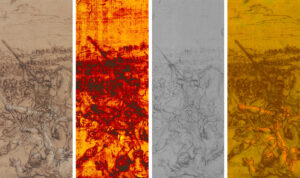
Pietro da Cortona, Alexanderschlacht; Auflicht, Durchlicht (Papierstruktur), NIR 940 (Vorzeichnung), UVF 365 nm (Bleiweißhöhungen, biologischer Befall) (v.l.n.r.)
Examinations of Painting in the Collection of Dutch, Flemish, and German Painting before 1800
In 2021, twenty-five major works in the Städel Museum’s Collection of Old Masters were examined with the M6 Jetstream. This took place in the context of the cooperation project of the Städel Museum, the Städel Cooperation Professorship at the Art Historical Institute of Goethe University, the Senckenberg Research Institute and Natural History Museum Frankfurt, and the Department of Material Analysis of the Technical University Darmstadt, funded by the Dr. Rolf M. Schwiete Foundation.
Macro X-ray fluorescence (MA-XRF) analysis with the M6 Jetstream enables the cutting-edge, state-of-the-art technological examination of historical paintings: The X-ray beam penetrates the sample and stimulates element-characteristic X-rays there, which can also leave the sample again from greater depths. This makes it possible to “look through” cover layers, such as those that can occur in paintings, in a non-destructive manner. The MA-XRF scans can thus make certain pigments and their distribution, as well as underpaintings or changes in composition, visible and expand our knowledge of the painting and creation processes of works of art.
The first results of the MA-XRF analyses of the paintings by Adam Elsheimer and Georg Flegel were published in 2021 in the scholarly catalogue of German paintings in the Städel Museum from the years 1550–1725, compiled by Almut Pollmer-Schmidt. In the run-up to the special exhibition “Rembrandt in Amsterdam”, the Rembrandt paintings in the collection were also examined. The MA-XRF analysis produced outstanding new findings on the genesis of the pictures, especially in the case of “The Blinding of Samson”, which were presented at the International Conference “New Technical Research on Rembrandt: Paintings, Drawings, Prints” on 21 and 22 January 2022 and presented online for the first time.
Another focus of the technological research of paintings, in cooperation with the Institute for Conservation Sciences at the State Academy of Fine Arts Stuttgart, was on testing a new method of infrared examinations with LED panels. By using five LED infrared panels that emit different, clearly defined wavelength ranges of the infrared spectrum, absorption properties of different underdrawing materials can be studied, and the underdrawings as a whole can be made more clearly visible. The infrared images are intended to refine and supplement the existing findings on the Early Netherlandish paintings in view of the planned new edition of the collection catalogue of Netherlandish paintings in the Städel Museum from the years 1400–1550.
Contact
Prof. Dr. Jochen Sander, Head of German, Dutch and Flemish Paintings before 1800

Collection Catalogue of German Paintings in the Städel Museum, 1550–1725
In the autumn of 2021, the two-volume, 808-page collection catalogue of German paintings in the Städel Museum from the years 1550–1725 was published by Deutscher Kunstverlag. The publication marks the successful conclusion of the comprehensive study of eighty-two individual works from the collection of German Baroque painting.
Since 2015, this scholarly examination has been funded by the German Research Foundation (DFG) and supported by the Städel Museum Association with the Christa Verhein Foundation. As with all previous scholarly catalogues of the Old Masters, this publication is characterised by the close interweaving of painting technological and art historical perspectives.
The core of the researched holdings includes the outstanding collection of paintings by Adam Elsheimer. Also worthy of mention are works by Johann Rottenhammer, Georg Flegel, Paul Juvenel the Elder, Johann Ulrich Mayr, and Johann Heinrich Roos, as well as portraits by unknown masters from the legacy of the Frankfurt patrician family von Holzhausen. Particularly with regard to Adam Elsheimer’s main work, the “The Altarpiece of the Holy Cross”, in-depth and – thanks to MA-XRF analysis – fundamental new insights were gained and published for the first time. The project was led by Almut Pollmer-Schmidt, while Christiane Weber carried out the technological analyses of the paintings.
Project lead
Dr. Almut Pollmer-Schmidt
Art technological research
Christiane Weber, M.A.

Adam Elsheimer
The Altarpiece of the Holy Cross, 1603–05
Städel Museum, Frankfurt am Main
Current
Conservation Projects

Conservation and restoration make it possible for artworks, even extremely fragile ones, to be presented to the public, and preserves them for future generations.
Pieter Aertsen, “Market Scene with Christ and the Adulteress”, 1559
Pieter Aertsen is an outstanding representative of Flemish Renaissance painting and one of the “inventors” of the genre of market scenes and kitchen interiors.
His painting is one of the major works of Flemish painting in the Städel Museum’s collection. It had long been on the agenda of the Department of Art Technology and Conservation - Paintings and Modern Sculptures, as both the support material (wooden panel) and the original layer of paint were in urgent need of conservation. In addition, materials applied during previous restorations, such as varnish coatings and retouchings, had discoloured and darkened due to ageing, so that the aesthetics of the painting’s surface were only partially visible.
The painting has been undergoing conservation since mid-2023.

Pieter Aertsen
Market Scene with Christ and the Adulteress, 1559
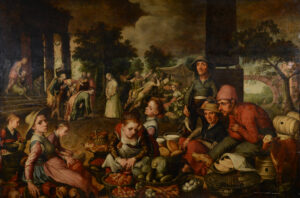
Condition prior to conservation

Detail during the uncovering
Karel Appel, “Portrait of Emmanuel Looten”, 1956
The “Portrait of Emmanuel Looten” is one of the series of “Têtes d’orage” (Storm Heads) executed by Karel Appel in Paris between 1955 and 1956. Appel painted the work on medium-thick natural-fibre fabric he evidently stretched and primed himself. The painting owes its vivaciously dynamic surface structure, which is highly characteristic of this artist’s style, to the wild, pastose paint application with wide brushes and palette knives. The artist added the black paint last simply by pressing it out of the tube onto the canvas.
Certain areas show cleavage between the paint layer and the ground over time. This phenomenon was the worst in the black areas, which had separated from the ground and were lifting. What is more, the surface of the paint layer was so severely soiled as to compromise the work’s aesthetic appearance. The treatment carried out in the Städel Museum’s conservation studio pursued the aim of preventing further loss of material and restoring the work’s original visual impact. Endangered areas of the paint layer were consolidated with an adhesive and the surface was cleaned. Losses were filled and, in a final step, retouched to integrate them into the colour scheme of the surrounding areas.
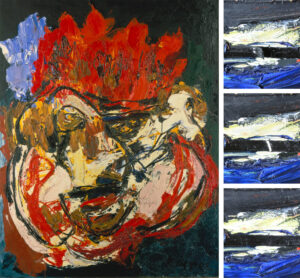
Karel Appel
“Portrait of Emmanuel Looten”, 1956; general view after completion of conservation (left), detail before conservation (top), detail during conservation (centre), detail after conservation (bottom)
Adolphe Monticelli, “A Painter at Work on a House Wall”, 1875
Measuring just 45.7 × 29.2 cm, the “Painter at Work on a House Wall” is small in scale. Adolphe Monticelli created it by applying extremely pastose paint to a mahogany panel that had previously served as an element of a piece of mahogany furniture. His technique evidently influenced how far more famous artists such as Vincent van Gogh handled oil paint. He applied the paint directly to the unprimed wooden surface and varnished it only in part. A complete coat of varnish was added within the framework of a later conservation measure. That varnish layer was extremely thick, particularly in the most distinctly pastose areas, and had darkened and yellowed to such a degree as to change the work’s colouration substantially.
The recent conservation treatment involved the careful removal of the non-original varnish under a microscope. No new varnish was applied to the surface of the painting. As a result, the overall image is much brighter and the colour scheme much cooler, and fine colour nuances are once again discernible. A decorative frame corresponding to the period of painting’s execution was purchased and now joins the pictorial composition to form a harmonious whole.

Adolphe Monticelli
“Painter at Work on a House Wall”, 1875
Before conservation (left), after completion of conservation (right), reverse (bottom left), painter’s legs before (bottom centre) and after varnish removal (bottom right).
Guido Reni, “Christ at the Column”, 1604
The two-year project of examining, conserving and restoring Guido Reni’s painting “Christ at the Column” was completed in 2022. The aim of the project was to improve the work’s aesthetic appearance, which had suffered severely from the consequences of material ageing and multiple earlier restorations. A yellowed layer of varnish, discoloured retouches, and old overpainting, inter alia, obscured the painting. As a result, the characteristic hue and the spatiality of the original work have been lost. The project got underway in 2021 with comprehensive scientific investigations such as micro-XRF scanning, which clarified important questions about the artist´s technique and working process as well as the damages and later interventions on the painting. Its subsequent treatment included the reduction of the varnish, the consolidation of the paint layer as well as the filling and retouching of losses. Due to the measures carried out, the fine color nuances and the interplay of light and shadow have reappeared, as did the sculptural design of the background and the contour lines of detailed areas of the paint layer. After nearly two years, the work recently returned to the exhibition rooms of the Städel Museum and was on view in the exhibition “Guido Reni: The Divine”.
The conservation measures were carried out with generous support from the Bank of America’s “Art Conservation Project”. The purchase of the decorative frame was made possible by contributions from Andreas Dreyer and Waltraud Schwendler as well as Alexandra Junior.
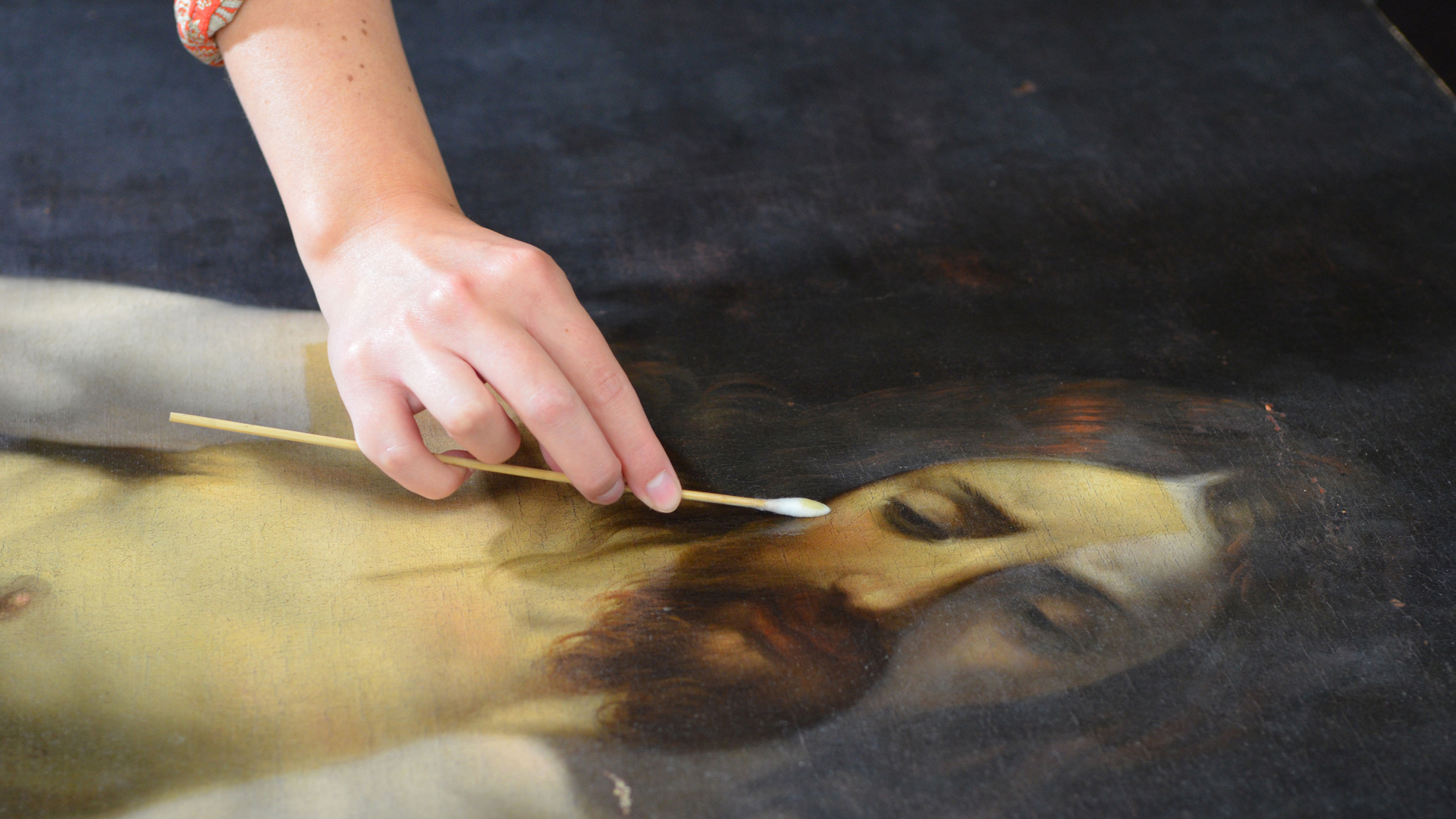
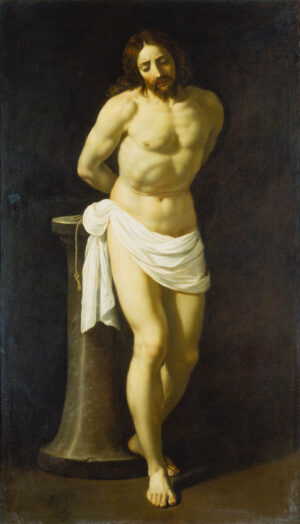
Guido Reni
Christ at the Column, ca. 1604
Technological Examinations of Paintings for the Collection Catalogue of German Baroque Painting
In 2021, work continued on the collection catalogue of paintings from the Baroque period in Germany. Here, the conservation department is conducting technological examinations of paintings by means of microscopy, ultraviolet rays, infrared rays, and X-rays and presenting the findings in the form of text contributions.
Since November 2019, the department has been carrying out analyses on works of art using macro X-ray fluorescence. For this purpose, a postgraduate position had been established for a period of four years with funds from the Dr. Rolf M. Schwiete Foundation.
Bernard Schultze, “Endymion”, 1955
The painting layer of the work “Endymion” by Bernard Schultze was in an extremely fragile condition, which gave rise to conservation and restoration measures.
Research into Schultze’s painting technique revealed that, until 1957, he mixed his own paints from pigments and linseed oil, occasionally adding sand to the so-called “paint slurry”. After he had applied the paint to the canvas, he doused some areas with turpentine. With regard to “Endymion”, it can be observed that, in addition to applying the paint with a brush, he also poured and dripped the paint onto the lying canvas. The colours blurred into each other or formed drip-like running traces. In the course of time, some of these drops detached themselves from the ground and protruded in a roof-like manner. In addition, imperfections formed in the painting layer.The measures carried out in the restoration studio of the Städel Museum aimed to prevent further loss of substance and to restore the original effect of the work. Endangered parts of the painting layer were therefore strengthened with an adhesive, missing areas were filled with a binder and finally integrated into the surrounding areas by retouching.

Bernard Schultze
Endymion, 1955
Wassily Kandinsky, “Kallmünz – Light-Green Mountains”, 1903
This early, small-format landscape painting by Wassily Kandinsky comes from the bequest of Ulrike Crespo and is painted in oil with a strongly impasto application of paint. The support is a painting board with a pre-primed canvas laminated on one side, which serves as the substrate for the pictorial composition.
In the course of an earlier restoration, a natural resin varnish was applied, which has since become very yellowed and darkened. The varnish affected the original colouring of the picture and was therefore carefully removed from the painting surface. After completion of the restoration, a copy of a frame profile common in the early 20th century was made, in which the painting is now presented in its original colour.

Wassily Kandinsky
Kallmünz—Light-Green Mountains, 1903
Ernst Ludwig Kirchner, “Head of Erna”, 1912
Working on originals is fundamentally a privilege. It allows one to get very close to the artist. In this case Kirchner, who carved his admiration for Erna Schilling into the wood. The sensitive portrait is characterised by clearly outlined zones and short parallel hatchings, as well as a now delicate colouring, which the artist applied with a brush and opaque paints. The woodcut was printed by hand. However, works on paper age and often also show traces of earlier mounting and older restorations.
If the works were framed and hung in the rooms of former owners, then sunlight often had a damaging effect. At first glance, the framed work under a passe-partout showed only general browning. When unframed, however, a strip-like browning caused by the incidence of light along the passe-partout window became apparent, as well as traces of previous water damage. Especially along the upper edge, dark water marks and stains became visible, while the paper tone in this area was several levels lighter. On the back of the work, there were old mounts and glue residues along the top edge.The challenge was to reduce the browning, the passe-partout shadow, and above all the traces of water damage, without endangering the printing ink, the colouring, or the inscriptions and stamps. The strong wavy warping in the upper part of the sheet was also to be reduced by removing the glue. After removing the old mounts and reducing the adhesive residue, the sheet was partially treated on a low-pressure table. Here, moisture – water or a solvent – applied with a brush is drawn through a perforated plate into an intermediate layer of blotting cardboard by negative pressure. Browning and stains are released from the paper and migrate into the blotting board. This enables a time-consuming but highly controlled local treatment. The treatment has now stabilised the woodcut and improved its condition. The restoration of the “Head of Erna” made it possible for this unique work to be given a befitting place in the exhibition “Tokens of Friendship”.

Ernst Ludwig Kirchner
Head of Erna, 1912
Conservation at the Städel

Conservation of Paintings and Modern Sculpture at the Städel Museum
Drawings, prints and photographs
The Städel Museum’s Department of Prints and Drawings has in its holdings more than 100,000 works on paper spanning the period from the fourteenth to the twenty-first century. The drawings, watercolours and pastels number about 25,000, the prints 70,000. The photography collection encompasses more than 5,500 historical and contemporary works.
Preventive measures are necessary to ensure that the fragile works retain as much of their original character and appearance as possible. The harmful effect of light can be minimized by exhibiting the works for a limited time only and in dim light. Damage to the works can also be avoided by controlling the temperature and humidity and employing premium-quality materials, for example for the mounts. It is also to this end that works on paper are always stored in passepartouts or specially produced portfolios.
To ensure the works’ permanent preservation, it is necessary to remove mounts and adhesive backings that have aged or are now known to be harmful, to clean the works and to repair tears that have come about, for example, through storage in portfolios of the wrong size, as well as to address damage caused by long exposure to daylight.
The prints and drawings conservation workshop moreover carries out technical examinations of drawings and prints to determine the medium/s, paper type and working process. These scientific analyses, which are among the methods taught in the framework of academic training and university-level paper conservation studies, are essential for the conservatorial treatment of the works while also providing insights of importance for art-historical research.
Paintings and modern sculptures
The Städel Museum’s Department of Art Technology and the Conservation of Paintings and Modern Sculptures oversees holdings of more than 3,000 paintings and three-dimensional objects spanning the period from the fourteenth century to the present, as well as numerous permanent loans which are integral parts of the museum collection.
One of the museum conservators’ key responsibilities is to develop concepts for preventive conservation. This task includes the optimization of the conditions under which artworks are presented in the museum galleries and kept in the storage facilities. Important factors here, for example, are the control of temperature and humidity as well as protection from light. What is more, globalization and global warming have led worldwide to the migration of vermin, a circumstance posing an increasing problem in many museums. The Städel Museum and its conservation workshops have responded by drawing up an Integrated Pest Management (IPM) plan including strategies for combatting so-called silverfish.
The conservators are also on the scene when a painting or sculpture is lent out to a partner museum somewhere in the world. They examine and document the work, prepare it for transport and often accompany the journey “from nail to nail”. The conditions of works the Städel receives from other museums as loans for its special exhibitions are documented with equal precision.
If one of the collection heads suggests purchasing a particular work for the collection, that work is likewise examined with a view to its condition and authenticity—if possible, in the conservation studio. If the respective work cannot be sent to the museum for inspection, the Städel conservators often travel to its location to carry out an initial analysis there.
Selection of Current
Acquisitions
The Städel Museum collects, preserves, researches and educates about works from over 700 years of art. The museum’s holdings are continuously expanded and developed through selective acquisitions and donations. Our annual report provides an overview of the individual new acquisitions per year.
Contact
Curatorial Team





